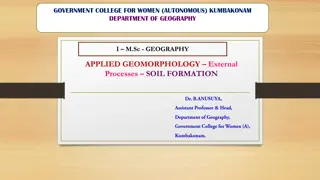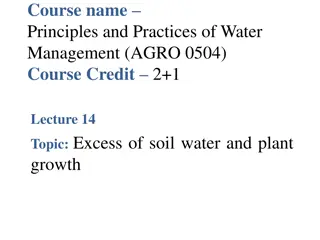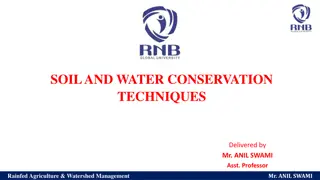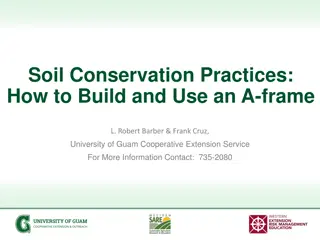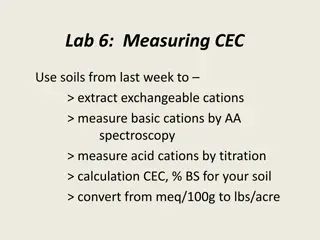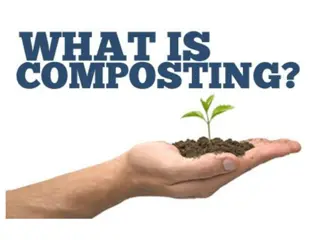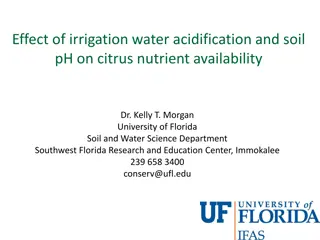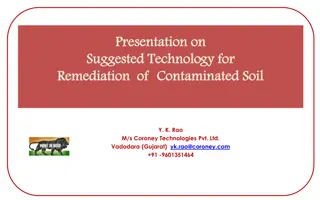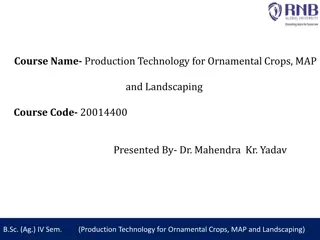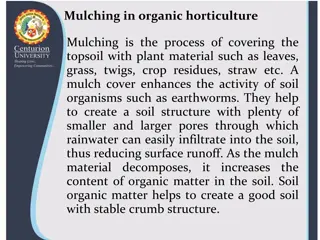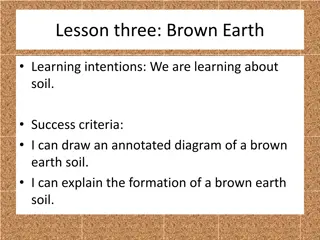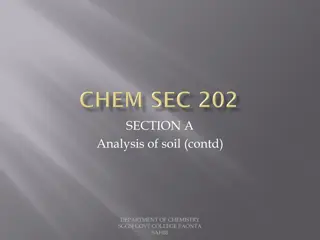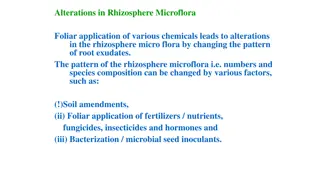Understanding Soil Life: The Key to Successful Gardening
Soil is more than just dirt - it's a living organism teeming with microorganisms that play a crucial role in the health and fertility of your garden. Finding the right balance of aerobic and anaerobic microorganisms, organic matter, nutrients, minerals, and pH levels is essential for creating a thriving garden environment. By respecting the circle of life within the soil and understanding how different microorganisms function, you can ensure optimal conditions for your plants to flourish.
Download Presentation

Please find below an Image/Link to download the presentation.
The content on the website is provided AS IS for your information and personal use only. It may not be sold, licensed, or shared on other websites without obtaining consent from the author. Download presentation by click this link. If you encounter any issues during the download, it is possible that the publisher has removed the file from their server.
E N D
Presentation Transcript
The Soil Inorganic solids (sand, clay .. ): carrier Minerals (K+, Ca2+, NO3-, SO42-, NH4+ ) Water Organic Matter Life in the soil Climate Acidity (pH) Will our gardening be successful? IT IS ALL ABOUT BALANCE
Soil is a living organism Respect the circle of Life (micro) organisms bacteria/mold/fungi/yeasts/amoeba bugs/nematodes/earth worms vegetables Good Life: BALANCE
VEGES BIOSPHERE/SOIL CONDITION MINERALS OUTPUT UNDERSTANDING THE BALANCE pH WATER INPUT ORGANIC MATTER NUTRIENTS (MICRO) ORGANISMS ANAEROBIC/AEROBIC
Micro-organisms .. Convert Organic matter into Nutrients and Minerals Conditioning the Soil Generating Heat Aerobic: in the presence of air (oxygen) Anaerobic: in the absence of air fermentation
Some micro organisms are facultative anaerobic or aerobic The circumstances determine how they behave Examples: Lactobacillus sp. Produce e.g. lactate (yoghurt, sourdough), acetate (vinegar) and some ethanol (alcohol).
Aerobic Micro-organisms .. (woodstove full blast) Bacteria Fungus Bugs Examples: compost, well-aerated soil More complete breakdown of organic matter (ultimately to carbon dioxide, water and minerals NO3-, SO42-, PO43-) With high energy production (heat)
Anaerobic Micro-organisms .. (woodstove during the night) Yeast Bacteria Examples: Sauerkraut, yoghurt, cheese, Bokashi, bread, beer, wine, free-living bacteria N-fixation, methane bacteria Partial breakdown of organic matter with many different nutrients produced As well as minerals NO2-, NH3, H2S, S Low energy release (most energy still in nutrients)
Garden soil needs both Anaerobic micro-organisms .. mainly to provide a range of organic nutrients to the roots (BUT some can produce less favourable substances) ..and Aerobic micro-organisms mainly to provide heat (energy) and minerals long-term stabilisation of the soil temperature
Anaerobic fermentation -produces nutrients -leaves organic matter largely unchanged to the eye -fermented organic matter can be composted more easily by Aerobic organisms
How can we promote a healthy balance in terms of soil micro organisms: bacteria? Reduce bad bacteria: Increase good bacteria: cause disease provide nutrients and protection against disease PROBIOTICS Good and bad compete partly for the same nutrients: add more good and the bad will disappear!
Lactobacillus sp. Probiotic Also for plants Found in: Sauerkraut, yoghurt, cheese, Bokashi
Lactobacillus sp. Easy to produce and to apply to soil and plants Found dormant on many plants and seeds e.g. rice, wheat, barley, oats Harvest bacteria/spores Revive Multiply Store/Apply
Lactobacillus sp. CAVEAT!! MPI fumigates imported foods such as rice (unless from Oz) MeBr kills bacteria and spores MeBr contributes to the ozone hole Unknown whether treated food affects your health
Lactobacillus sp. Harvest bacteria/spores Wash grains with non-chlorinated water and collect first wash ( whitish water: starter) or make sourdough starter Contains some bacterial and fungal spores
Lactobacillus sp. Revive bacteria/spores Let starter sit under cover of cloth (flies) For about a week Warm-ish spot Smells a little sour Precipitate-liquid-top layer
Lactobacillus sp. Multiply bacteria/spores Collect the starter liquid Mix 1+10 with milk Let starter sit under cover of cloth (flies) Or in a fermentation pot For about a week Warm-ish spot Smells cheesy
Lactobacillus sp. Multiply bacteria/spores Top layer Curd: Cheese Middle layer Whey+bacteria: green-ish = concentrated LAB serum Bottom layer
Lactobacillus sp. Apply/Store Collect middle layer = conc. LAB serum Dilute (ncw) LAB serum 1:20 | Dilute (ncw) LAB application solution (1:20) Apply before sowing, when planting, transplanting, spraying of diseased plants
Lactobacillus sp. Apply/Store This is the workhorse of the beneficial bacteria. Many other uses: Foul odors, clogged drains, septic tanks, cheaper pig/chicken/etc farming, aquaculture, ponds, drink, ointment
Lactobacillus serum Lactic-acid producing bacteria (LABs) are known to have various beneficial qualities such as anti-tumour activity, reduction of serum cholesterol, alleviation of lactose intolerance, stimulation of the immune system, enhancement of resistance against pathogens and prevention of traveller s diarrhoea (Aimutis 1999; Reid 2006).
Plant growth/health promotors Lactobacillus Serum Homemade Fish Fertilizer BIM CalPhos Grow Fertilizer Bloom Fertilizer Immuboost Ginger-Garlic Extract Neem Extract Bokashi Biochar Cockroach Composting Cover Crops Worm Composting Compost Tea theunconventionalfarmer.com ofrf.org ecologiesurleweb.free.fr






















